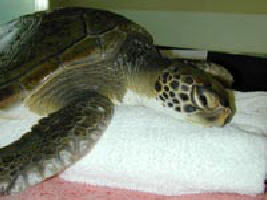|
Endangered green sea turtle rescued
By Mark Alan Lovewell
Vineyard Gazette
The Vineyard Gazette
19th November 2004
A 17-pound live green sea turtle found on Chappaquiddick more than a week ago is recovering at the New England Aquarium. The turtle, nicknamed Quiddick by a Vineyard veterinarian who first treated it, is the first endangered green turtle recovered live from the Vineyard.
Scientists report the animal was stranded in cold water. Each year at this time dozens of cold-stunned endangered sea turtles are recovered along the shores of Cape Cod Bay, but this is the first for the Vineyard. All recovered live turtles are sent to the New England Aquarium for treatment, revived and later returned to the sea.
The health report out of the New England Aquarium for Quiddick this week was good.
"Quiddick is doing pretty well," said Connie Merigo, a coordinator for the marine animal rescue program at the aquarium. Quiddick is one of seven turtles now in the aquarium's care. Ms. Merigo said bringing the reptiles back to a full recovery is tough work. One of the seven is not expected to survive, but she said Quiddick is doing really well for its size and age, which is believed to be about three years. The turtle is too young to determine its sex.
"We've got the water temperature back up to 75 degrees. He has just started to eat on his own. He is still a bit slow and that is normal for a cold-stunned turtle," said Ms. Merigo. Water temperatures around the Vineyard are 50 degrees or colder right now.
The turtle was discovered on Wednesday, Nov. 10, at about 1 p.m. on the eastern shore of Cape Pogue Pond by Allan Keith, a well-known Chilmark naturalist and birder. Mr. Keith, who is familiar with the plight of cold-stunned sea turtles, transported Quiddick to the Vineyard Veterinary Clinic in Edgartown. The next day the turtle was transported to the New England Aquarium by volunteers.
Dr. Bridget Dunnican, a veterinarian with the Edgartown clinic, was among the first to see the animal, and she named it. Dr. Dunnican also works at the National Oceanic and Atmospheric Administration's Woods Hole Science Aquarium and is experienced with sea turtles. She described the animal as in pretty good physical health. There was a small skin lesion on the top of its neck. "We are hoping it will make a full recovery. Once stable it will be brought to the Woods Hole Science Aquarium, rehabilitated and then released next summer," she said.
Gus Ben David, director of Felix Neck Wildlife Sanctuary, has seen a number of dead sea turtles on the Vineyard's shore. Last year he with others helped recover a dead 150-pound loggerhead on the south shore. "I see them mostly in some state of decay. We have had close to eight to 10 loggerhead sea turtles in the last 35 years. I have never seen a live green sea turtle on the Vineyard," Mr. Ben David said.
Green sea turtles reside in all the world's oceans. According to one journal they are known to reside in coastal bays. When first hatched they are no bigger than two inches in size and can grow to 350 pounds with a shell that can be as much as 3.5 feet in length. Green sea turtles can live up to 80 years. They do not reach sexual maturity until they are 25 years old, and it is difficult to determine sex before then. Endangered green sea turtles are protected by federal and state regulations.
Because they are reptiles, sea turtles adjust their body temperature to their environment. When the water begins to turn cold, turtles instinctively swim south to find warmer water. Turtles north of Cape Cod often get caught in the bay.
Tony LaCasse, a spokesman for the New England Aquarium, said in one autumn his staff may see or learn about more than 100 animals. The most rare and heavily protected sea turtle is the Kemp's Ripley turtle, and every year they see a couple of them.
When the water temperature drops too low, the animals become immobile and may end up on the beach. Without human intervention, they die. With population numbers dwindling in the Atlantic, there is an intense effort to save any living turtle that comes ashore. A marine mammal network that normally works with dolphins and whales shifts into protecting sea turtles in the fall.
Ms. Merigo said cold-stunned sea turtles look as though they are almost dead. Recovery is complicated. The animal's body temperature is raised very slowly and vital signs are monitored closely. Ms. Merigo said Quiddick will likely make full recovery.
Mr. Keith said he believes the turtle probably got into Cape Pogue Pond and couldn't find its way out before cold weather set in.
Mr. Keith said people walking the beach at this time of year should be on the lookout for cold-stunned sea turtles. "Anybody who finds a cold-stunned turtle, instead of leaving it there, should pick it up and transport it to a vet immediately," Mr. Keith said. "The sooner it is transported to a veterinarian, the better. They need attention right away. Don't leave it there, unless it is too big to handle," he added.
Dead marine mammals and sea turtles are protected by state and federal regulations and should not be touched.
Anyone spotting a live marine mammal or sea turtle should call the New England Aquarium hotline at 617-973-5247.
Top
|
